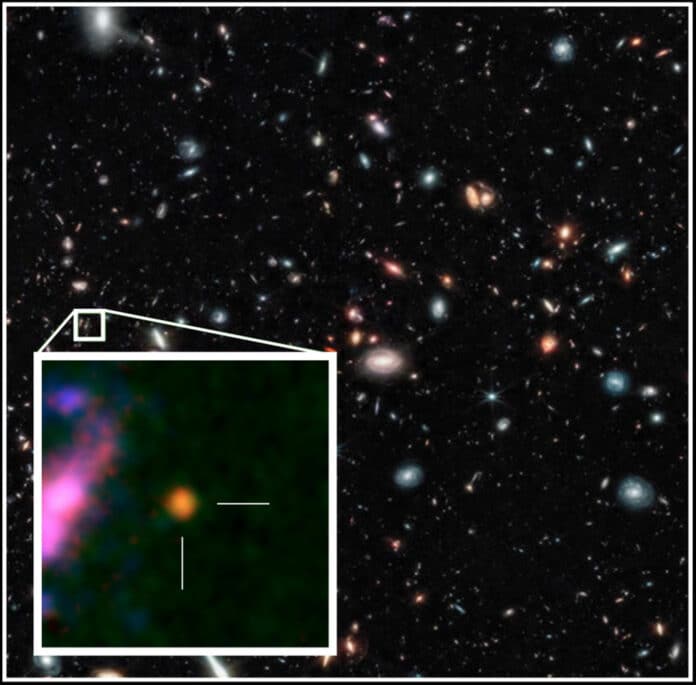The JWST has discovered abundant bright galaxy candidates in the early universe. The observations challenged our basic understanding of the formation of the earliest galaxies.
Spectroscopy is needed to confirm the primeval nature of these candidates, as well as to understand how the first galaxies form stars and grow. In a new study, astronomers presented deep spectroscopic and continuum ALMA observations of the galaxy named GHZ2/GLASS-z12.
Astronomers at the National Astronomical Observatory of Japan and Nagoya University have collaborated on a new study that measures the cosmic age of a far-off galaxy- GHZ2/GLASS-z12. Using the ALMA radio telescope array, they discovered a radio signal traveling for around 97% of the universe’s lifetime. The James Webb Space Telescope’s discovery of galaxies in the very early Universe is now confirmed by this finding.
Since it takes so long for the light from distant galaxies to reach us, the Universe’s expansion has caused this light’s color to shift toward the red end of the visible light spectrum, or what is known as redshift. As a result, GHZ2/GLASS-z12 was one of the most persuasive candidates for a distant galaxy that was spotted thanks to its red color.
Two early-career researchers from Nagoya University and the National Astronomical Observatory of Japan used the forty radio telescopes of the ALMA array in Chile to search for a spectral line to confirm the true ages of the galaxies shortly after the discovery of these early galaxy candidates.
To search for an emission line linked to oxygen at the anticipated frequency provided by the JWST observations, ALMA pointed at GHZ2/GLASS-z12. Due to the relatively quick timescale for oxygen’s creation in distant galaxies, the team decided to look for an oxygen emission line to boost the likelihood of detection.
ALMA was able to find the emission line around the location of the galaxy by integrating the signals from each of its 12 m telescopes. According to the line’s observed redshift, we can view the universe as just 367 million years after the Big Bang.
Lead author Tom Bakx of Nagoya University said, “The first images of the James Webb Space Telescope revealed so many early galaxies that we felt we had to test its results using the best observatory on Earth. It was a very exciting time to be an observational astronomer, and we could track the status of the observations that will test the JWST results in real-time.”
“We were initially concerned about the slight variation in position between the detected oxygen emission line and the galaxy seen by Webb, but we performed detailed tests on the observations to confirm that this is a robust detection, which is very difficult to explain through any other interpretation.”
Co-lead author Jorge Zavala of the National Astronomical Observatory of Japan adds, “The bright line emission indicates that this galaxy has quickly enriched its gas reservoirs with elements heavier than hydrogen and helium. This gives us clues about the formation and evolution of the first generation of stars and their lifetime. The small separation between the oxygen gas and the stars’ emission might also suggest that these early galaxies suffered from explosions that blew the gas away from the galaxy center into the region surrounding the galaxy and even beyond.”
“These deep ALMA observations provide robust evidence of the existence of galaxies within the first few hundred million years after the Big Bang and confirms the surprising results from the Webb observations. The work of JWST has only just begun, but we are already adjusting our models of how galaxies form in the early Universe to match these observations. The combined power of Webb and the radio telescope array ALMA gives us the confidence to push our cosmic horizons ever closer to the dawn of the Universe.”
Journal Reference:
- Tom J L C Bakx, Jorge A Zavala et al. Deep ALMA redshift search of a z ∼ 12 GLASS-JWST galaxy candidate. Monthly Notices of the Royal Astronomical Society. DOI: 10.1093/mnras/stac3723
